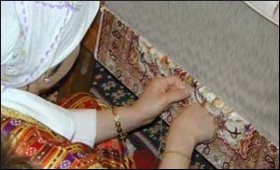|

|
GI Tag: Varanasi-Mau-Bhadohi leading in UP
|
|

|
|
| Top Stories |
 |
|
|
|
Saurabh Gupta | 26 Jun, 2013
Varanasi, Bhadohi and Mau clusters, the three very renowned districts of Uttar Pradesh (UP), are now having the Geographical Indications (GI) tag. A GI tag is defined as that the goods produced in the particular region are the intellectual property of that region. Brocades and Sarees of Varanasi and handmade carpets of Bhadohi are registered under the handicraft goods while Sarees & Fabrics of Mau are registered under textile goods of GI Act 1999 under the Section 2 (f).
Varanasi is famous for its Brocades and Silk Sarees:
Varanasi weaving industry reached its zenith during Mughal period. Late Mughal emperor Akbar introduced the Persian motifs with the help of a Persian master named Ghias Nakshaband during his period. The brocade weaving industry went under a drastic change during this period. European visitors in early 17th century also confirmed Varanasi as textile production center.
Varanasi is one of the rich weaving craft centres of India, famous for its unique brocades and silk sarees. These were registered under GI in 2009. Brocade is a class of richly decorative shuttle-woven fabrics, often made in colored silks and with or without gold and silver threads. The most important material in brocade weaving is silk. It facilitates lovely weaves, is durable, strong, fine and smooth. Varanasi weavers are also equally famous for the intricate and delicate sarees.
Mau is a power-loom cluster of Eastern UP:
Mau has been a weaving centre right from the early Mughal period in the 16th century, when a large number of weavers from Iran, Afghanistan and Turkey settled down in Mau.
Now Mau is an important power-loom cluster in eastern UP. According to the 1998 -99 MSME Census the total numbers of Handloom/ Power-loom units in Mau district were 58,381. Most of the Power loom units are concentrated in semi urban, or rural area. With registration of Mau clusters as GI, this region will get benefit to confer legal protection to Geographical Indications in India. GI prevents unauthorized use of a registered Geographical Indication by others.
Hand knotted carpets of Bhadohi are unique in world:
Bhadohi carpet belt in Uttar Pradesh supports the largest handmade carpet industry of the world. Handmade carpets of Bhadohi are manufactured through knot-by-knot technique. There is no machine that can tie knots the way human fingers can. Hand knotting gives the carpet its essential quality - its uniqueness. Even when the colour schemes and designs are similar, no two pieces can be ever alike because of this unique technique. The whole process is entirely manual starting from weaving, designing, washing, finishing etc. The process of course is highly painstaking and need practice. The art of carpet weaving is passed on from generation to generation in this area. The knots give carpets a soft cushioned feel which exudes luxury. The pattern can be anything from a traditional oriental intricate style to a very modern minimalist representation.
Richness of a handmade carpet is decided mainly by the number of knots per sq. meter i.e. higher number of knots means better quality. Also the material used play a major role is deciding the quality of the carpet. Due to change in fashion and trends the consumer are showing interest for diversified products like Hand tufted carpets, Wall hangings, Welcome Pads, Asani for prayer. Bhadohi carpet cluster is scattered across Bhadohi district and some parts of Mirzapur, Varanasi, Ghazipur, Son Bhadra, Kaushambi, Allahabad, Jaunpur, Ghazipur, Chandauli districts.
By getting the GI tag will help about two million rural artisans and about 2500 small scale enterprises with about 20000 small supporting units are successfully catering to the ever changing world of handmade carpets. Bhadohi carpet weavers weave carpet independently with help of a graphical design, which involve better skills. The traditional art of carpet weaving has proved its metal in the world market as a leader.
The GI tag ensures that none other than those registered as authorised users (or at least those residing inside the geographic territory) are allowed to use the popular product name. GI enables seeking legal protection in other WTO member countries and boosts exports of Indian Geographical indications by providing legal protection. Such protection will definitely change the overall picture of these regions and also the economic conditions of the poor artisans.
|
SEE ALSO
|
| |
|
|
|
|
|
|
|
GI Tag: Varanasi-Mau-Bhadohi leading in UP
Ashok | Thu Jun 27 03:04:55 2013
But still all three regions need proper attention by the state as well as by the central government. There were lot many problems of workers need to be addressed.

|
|
|
|
|
|
|
| |
| Customs Exchange Rates |
| Currency |
Import |
Export |
US Dollar
|
â¹91.25
|
â¹89.55 |
UK Pound
|
â¹122.85
|
â¹118.85 |
Euro
|
â¹107.95
|
â¹104.3 |
| Japanese
Yen |
â¹59 |
â¹57.1 |
| As on 29 Dec, 2025 |
|
|
| Daily Poll |
 |
 |
| What is your biggest hurdle to scaling right now? |
|
|
|
|
|
| Commented Stories |
 |
|
|
|
|
|
| |
|